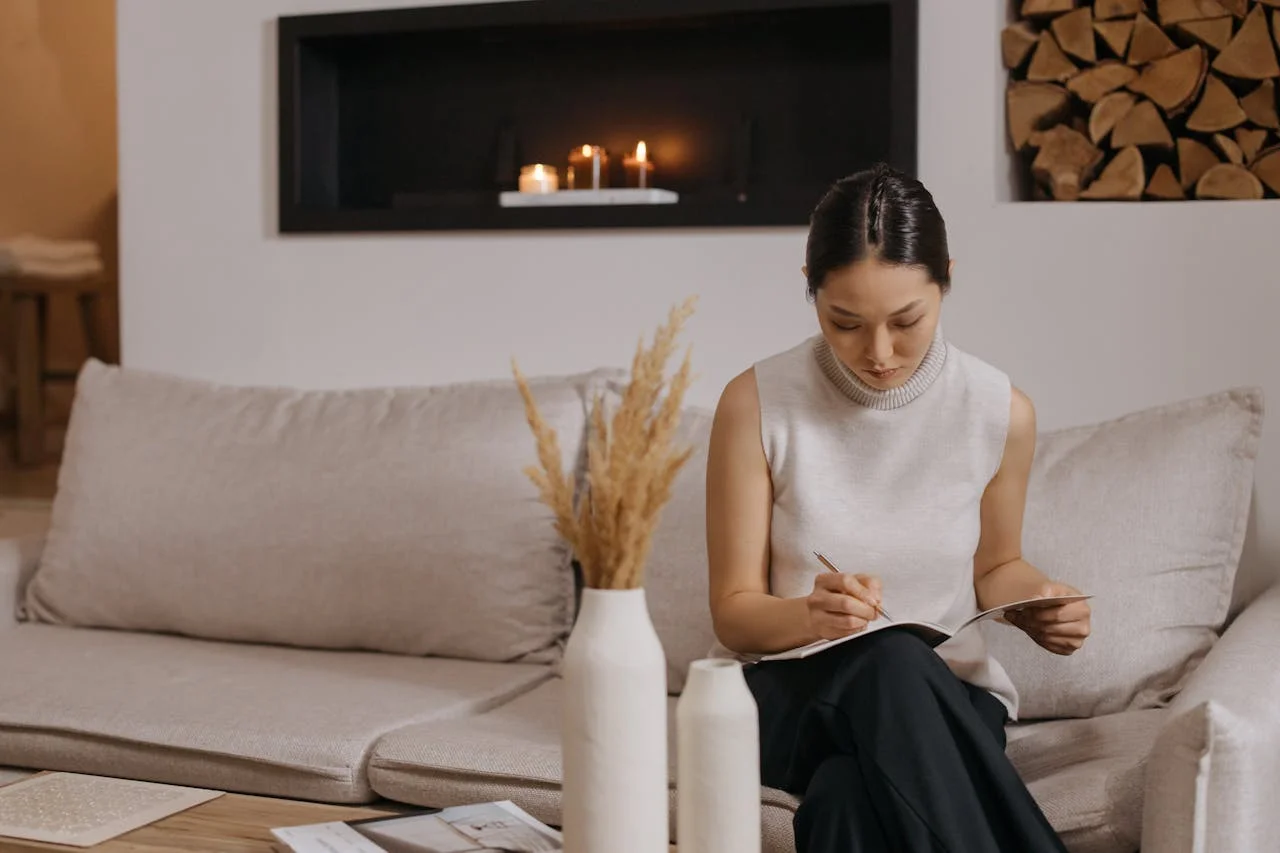
Your home’s current state is working against you, creating mental static that follows you from room to room. I can tell you that most people don’t realize how their cluttered countertops, dim corners, and constant device buzz are quietly draining their energy throughout the day. You’re fighting an uphill battle for peace when your environment sends chaos signals to your brain. But here’s what I’ve discovered about transforming any space into a sanctuary that actually supports your well-being.
Declutter High-Traffic Areas for Visual Breathing Room
When you walk into your home after a long day, cluttered surfaces and crowded pathways create instant stress before you’ve even set down your keys. I can tell you from years of helping clients transform their spaces, your entryway and main living areas demand immediate attention.
Start with surfaces you see first – kitchen counters, coffee tables, dining room tables. Clear everything except one or two meaningful items. I’ve never seen anyone regret having empty space to breathe.
Next, tackle walkways. Remove furniture that forces you to sidestep or squeeze through. You’re the decision-maker here, and every item should earn its place.
Focus on these high-impact zones first. You’ll feel the difference within minutes, and that momentum will carry you forward. A structured decluttering planner can help you systematically work through each area of your home, ensuring no corner gets overlooked in your quest for calm.
Create Natural Light Pathways Throughout Your Space

Natural light transforms your home’s energy more powerfully than any expensive renovation, yet most people block it without realizing the damage they’re doing to their daily mood. I can tell you that opening these pathways requires strategic ruthlessness with your furniture placement.
Move heavy bookcases away from windows immediately. Position mirrors directly across from light sources to bounce illumination deeper into rooms. I’ve never seen a space that couldn’t benefit from removing thick curtains in favor of sheer panels that filter without blocking.
Clear windowsills completely—those decorative objects are stealing precious light. Trim outdoor bushes that cast shadows through glass. Choose light-colored walls near windows to amplify reflection. These changes cost nothing but create the bright, energizing atmosphere that makes slow living actually sustainable.
Consider bringing spring flowers like cherry blossoms or peonies near your brightest windows to enhance the natural light with soft, calming colors that complement your newly opened pathways.
Establish Device-Free Zones for Digital Detox
Your phone’s blue glow at midnight destroys the peaceful sanctuary you’re trying to build, and I can tell you that creating boundaries requires more than willpower—it demands physical barriers.
I’ve never seen anyone successfully detox while keeping devices within arm’s reach. You need designated zones where technology simply doesn’t exist, and this creates immediate mental relief.
Transform your bedroom into a sacred space by removing all screens, charging stations outside the room. Your dining area becomes a connection hub when phones stay in a basket by the front door. I can tell you that physical separation works because your brain stops expecting constant stimulation.
Physical separation from devices rewires your brain to stop craving constant digital stimulation and creates genuine mental peace.
Powering down electronics at least 30 minutes before bed allows your melatonin production to increase naturally, supporting your body’s transition into sleep mode.
- Remove charging cables from bedrooms and living areas
- Install a charging station near your home’s entrance
- Create phone-free meal times with a designated basket
- Establish a “sunset rule” where devices power down after dinner
- Use analog clocks instead of phone alarms
Incorporate Soft Textures and Natural Materials
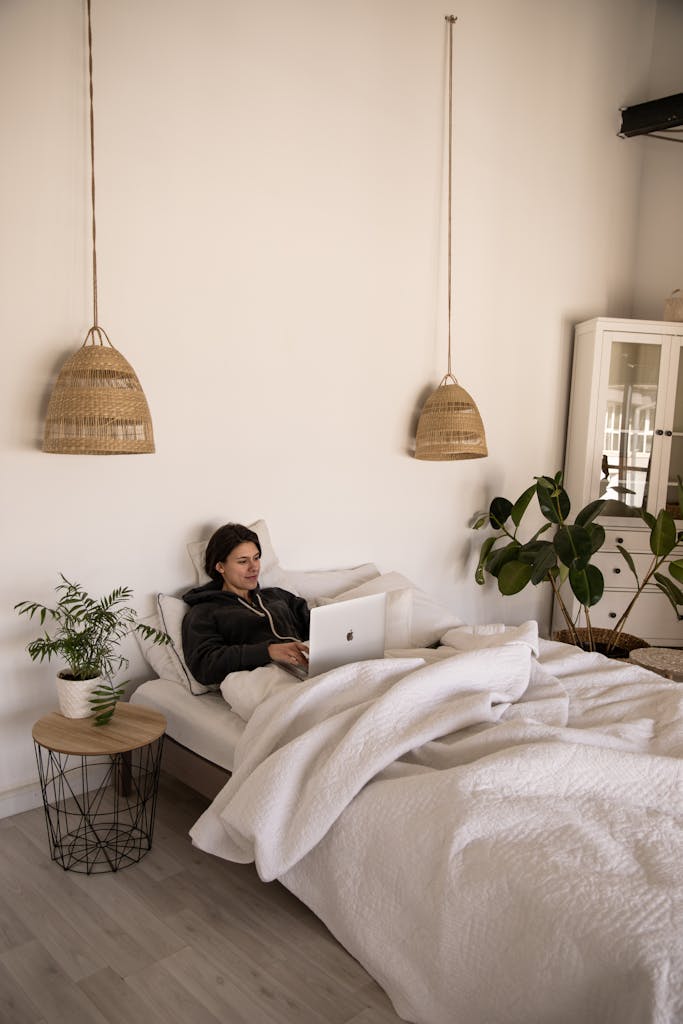
Creating these peaceful, tech-free spaces becomes infinitely more inviting when you surround yourself with materials that naturally calm your nervous system. I can tell you from years of experience, your brain responds instantly to organic textures like linen throws, wool rugs, and raw wood surfaces. These materials ground you in ways synthetic fabrics simply can’t match.
Replace plastic storage bins with woven baskets, swap out metal lamp bases for ceramic or wood alternatives, and layer soft cotton cushions on your reading chair. I’ve never seen anyone stressed while running their fingers across smooth river stones or touching a chunky knit blanket. Your home becomes a sanctuary when every surface invites touch, connection, and authentic comfort that speaks to your primal need for natural elements.
In your workspace especially, layered textiles like soft blankets and plush pillows can transform even the most utilitarian area into a cozy retreat that supports both productivity and well-being.
Design Dedicated Quiet Corners for Reflection
Sanctuary starts with a single chair positioned away from your home’s main traffic flow, where you can sit without interruption and simply breathe. I can tell you that creating this dedicated space transforms your entire relationship with stress, giving you immediate access to calm whenever life demands it.
Your quiet corner doesn’t need elaborate design—it needs intentional positioning. I’ve never seen anyone regret placing their reflection spot near a window with natural light, away from television noise and household chaos. This becomes your command center for mental clarity.
Position your chair facing away from doorways to minimize visual distractions
Add a small side table for journal, tea, or meaningful objects
Include a soft throw blanket for physical comfort and psychological safety
Keep the area clutter-free with only essential, calming items
Place a plant nearby to enhance the natural, grounding atmosphere
This peaceful retreat encourages the practice of mindful eating when you bring your morning coffee or afternoon tea to this space, allowing you to fully appreciate each sip without the usual household distractions.
Simplify Color Palettes With Calming Earth Tones
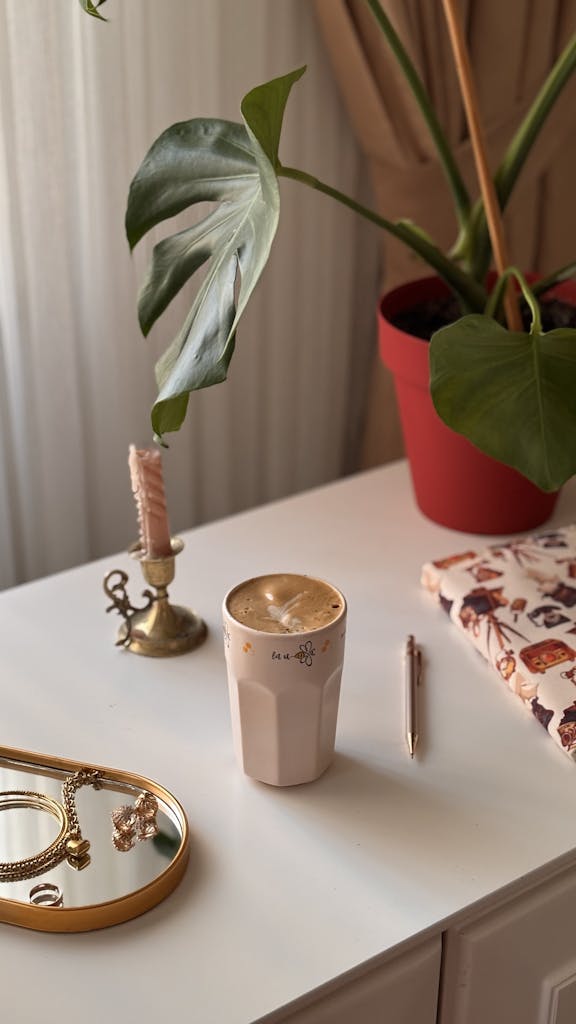
Once you’ve established your peaceful reflection space, the colors surrounding it—and throughout your entire home—will either support or sabotage your slow living goals. I can tell you from years of working with overwhelmed clients, chaotic color schemes create mental chaos. Your power lies in choosing wisely.
Strip away the bright yellows, electric blues, and jarring oranges that assault your senses daily. Replace them with warm terracotta, soft sage green, creamy beige, and muted clay tones. These earth colors don’t just look calming—they actively reduce cortisol levels.
I’ve never seen anyone regret painting their bedroom walls in warm mushroom gray or their living room in gentle sandstone. These colors work because they mirror nature’s palette, instantly grounding your nervous system and supporting deeper rest. Consider extending this seasonal approach to your desktop wallpaper, where autumn earth tones can reinforce these calming colors throughout your daily digital interactions.
Add Living Plants to Purify Air and Energy

While you’re transforming your home’s color palette, you’re missing a crucial element that’ll amplify every calming change you make—living plants that work around the clock to clean your air and shift your home’s energy.
Living plants are the missing piece that transforms your color transformation into a complete sanctuary—working silently to purify and energize your space.
I can tell you from experience, the right plants transform stagnant spaces into vibrant sanctuaries. Snake plants eliminate toxins while you sleep, pothos cascade down shelves creating natural flow, and peace lilies signal when they need water by drooping slightly.
Choose low-maintenance varieties like ZZ plants or rubber trees for busy lifestyles.
Place larger plants in corners to soften harsh architectural lines.
Group plants in odd numbers for visual balance and natural appeal.
Select ceramic or terracotta pots that complement your earth-tone palette.
Position plants near windows but away from direct harsh sunlight.
Whether you’re creating a dedicated meditation nook or simply adding greenery to your living room, plants enhance both air quality and create the tranquil atmosphere essential for slow living.
Organize Storage Systems That Hide Daily Chaos
Even the most beautifully curated rooms fall apart when clutter creeps across surfaces, and I’ve learned that strategic storage systems make the difference between a home that breathes calm and one that constantly whispers stress.
You need hidden storage that works harder than it shows. I can tell you that closed cabinets with adjustable shelves beat open shelving every time for daily chaos. Install drawer organizers in your kitchen, bathroom vanities, and bedroom dressers. You’ll find everything instantly without the visual noise.
I’ve never seen a peaceful home without designated spots for keys, mail, charging cables, and random items that migrate daily. Create landing zones with concealed compartments near your entryway. When everything disappears behind clean doors, your mind automatically shifts into calm mode.
However, if you struggle with out-of-sight, out-of-mind tendencies, consider placing clear containers inside these closed storage areas so essential items remain visible while maintaining that clean exterior aesthetic.
Set Up Mindful Rituals Around Daily Transitions
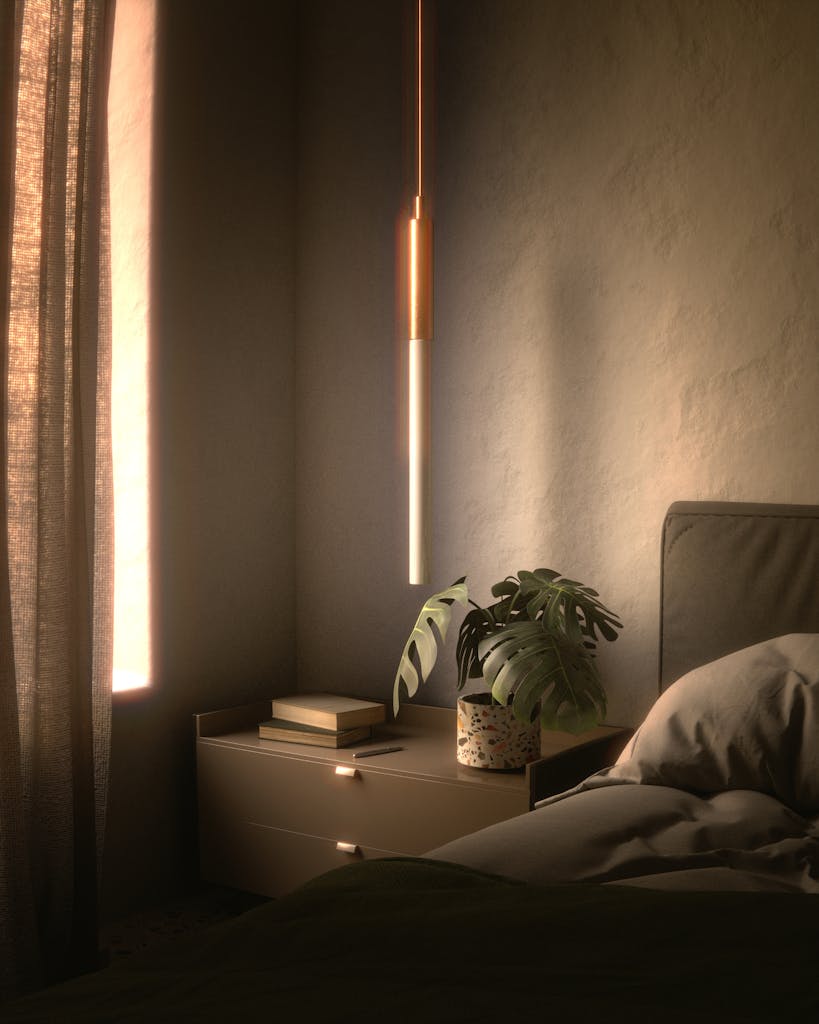
Because changes jolt us from one mental state to another, I’ve discovered that intentional rituals during these daily shifts create the breathing room slow living demands. You’re essentially training your nervous system to pause instead of racing forward, and I can tell you this alters everything about how you experience your home.
These conversion rituals become your personal reset buttons, giving you control over the energy you bring into each space and activity. The key is consistency over intensity, as even a few minutes of intentional ritual can be more beneficial than elaborate routines you won’t maintain.
- Light a candle when you enter your bedroom to signal rest mode
- Take three deep breaths before opening your laptop for work
- Play the same calming playlist during your evening wind-down routine
- Create a physical gesture like washing your hands to mark work’s end
- Set out tomorrow’s clothes as a mindful closure to today
Conclusion
You don’t need to transform your entire home overnight to feel the benefits of slow living. I can tell you that even implementing two or three of these changes will shift your space’s energy dramatically. Start with decluttering one high-traffic area, then add a device-free zone. You’ll notice the calm spreading through your daily routines, creating the peaceful sanctuary you’ve been craving without overwhelming yourself.



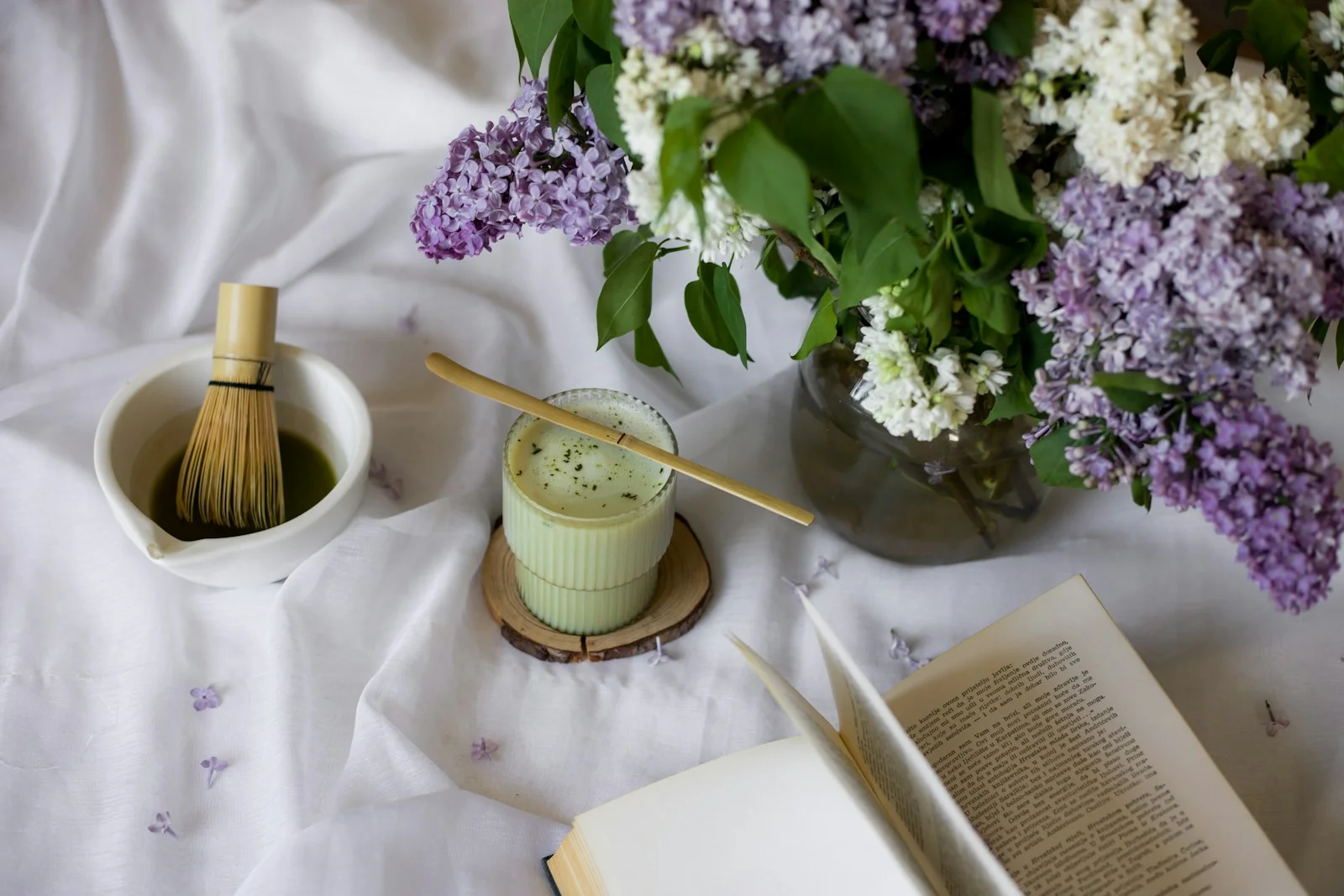

Leave a Reply